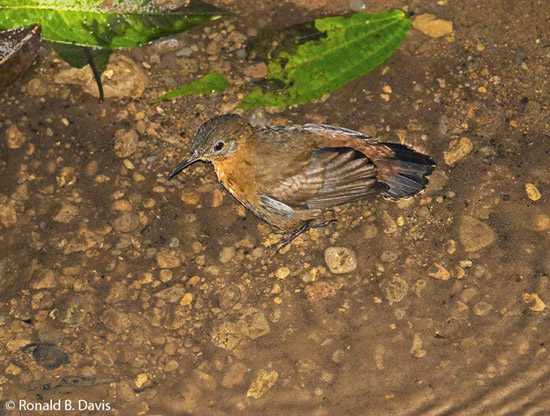
Photo © by Ronald B Davis
Rancho Naturalista near Turrialba Costa Rica, December, 2015
- Sclerurus mexicanus
Disambiguation: This species is a daughter species after split of the former species Tawny-throated Leaftosser; naming of this species is complicated by the fact that one checklist tentatively retained the name Tawny-throated Leaftosser for this daughter species.
Identification
15–17 cm (6-6¾ in)
- Long thin bill
- Dark brown overall plumage
- Rufous on throat to breast and rump
- Upperside of tail is dusky
Variation
Bill is longer and there is more rufous on the breast of the northern subspecies.
Similar species
Compared to South American Leaftosser, this species has a longer bill, and more rufous on throat and breast. It also has a slower song.
Distribution
Central:
Central America: Mexico, Baja California, Guatemala, Belize, El Salvador, Honduras, Nicaragua, Costa Rica and Panama
Taxonomy
This species was formerly considered a part of Tawny-throated Leaftosser together with South American Leaftosser
Subspecies
Two subspecies recognized[1]:
- S. m. mexicanus from tropical southeast Mexico (Veracruz and Chiapas) to Honduras
- S. m. pullus from Costa Rica to western Panama; eastern Panama (Mount Tacarcuna) (The identity of birds in eastern Panama is not certain).
Habitat
Humid forests from tropical lowland to mainly subtropical montane humid forests at elevation up to around 2200m.
Behaviour
Action
Hops on the ground, flipping over leave litter. If disturbed, it will fly to a nearby perch on a low branch.
Diet
Their diet consists mostly of invertebrates.
Vocalisation
The song of these two subspecies are similar in most aspects such as containing about 4 notes within 3-3,5 s with the highest pitch on first note. Each note is generally "n" shaped with initial increase in pitch followed by a slow fall and then ending in an abrupt fall in pitch. A difference is that the maximum pitch reached is higher in S. m. pullus with peak pitch difference of more than 1000 hz[3].
References
- Clements, J. F., T. S. Schulenberg, M. J. Iliff, D. Roberson, T. A. Fredericks, B. L. Sullivan, and C. L. Wood. 2018. The eBird/Clements checklist of birds of the world: v2018. Downloaded from http://www.birds.cornell.edu/clementschecklist/download/
- Birdforum thread discussing possible split of this species
- Paper by Cooper and Cuervo (2017) describing vocal differences in Rufous-throated and Tawny-throated Leaftossers
- Cooper, J. C., D. F. Barragán, R. C. Juárez-Jovel, and P. F. D. Boesman (2021). Middle American Leaftosser (Sclerurus mexicanus), version 1.1. In Birds of the World (T. S. Schulenberg, Editor). Cornell Lab of Ornithology, Ithaca, NY, USA. https://doi.org/10.2173/bow.tatlea1.01.1
- SACC proposal detailing the arguments for splitting Tawny-throated Leaftosser into two or more species
Recommended Citation
- BirdForum Opus contributors. (2025) Middle American Leaftosser. In: BirdForum, the forum for wild birds and birding. Retrieved 18 May 2025 from https://www.birdforum.net/opus/Middle_American_Leaftosser
External Links
GSearch checked for 2020 platform.



